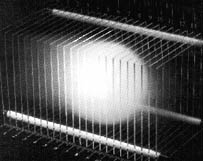Zapped
 this is where physics meets medicine. The science of particle beams may be quite beyond the limits of medical science, but the two might soon collaborate, with results that may surprise many doctors (of medicine, that is). Two new research programmes in Europe have begun exploring down-to-earth uses for two different types of particle beams: treating patients with intractable brain cancer. Recently, the European Union's ( eu ) commissioner in charge of research, Edith Carson, inaugurated a five-nation programme of tumour therapy using neutron beams from the high-flux reactor at eu 's Joint Research Centre in Petten, the Netherlands. And soon, two patients will get a first indication of whether a carbon-ion beam therapy developed at Germany's heavy-ion research centre ( gsi ) in Darmstaldt has halted the growth of their tumours ( Science , Vol 279, No 5352).
this is where physics meets medicine. The science of particle beams may be quite beyond the limits of medical science, but the two might soon collaborate, with results that may surprise many doctors (of medicine, that is). Two new research programmes in Europe have begun exploring down-to-earth uses for two different types of particle beams: treating patients with intractable brain cancer. Recently, the European Union's ( eu ) commissioner in charge of research, Edith Carson, inaugurated a five-nation programme of tumour therapy using neutron beams from the high-flux reactor at eu 's Joint Research Centre in Petten, the Netherlands. And soon, two patients will get a first indication of whether a carbon-ion beam therapy developed at Germany's heavy-ion research centre ( gsi ) in Darmstaldt has halted the growth of their tumours ( Science , Vol 279, No 5352).
Researchers at Petten are the first in Europe to use a technique called boron neutron capture therapy, which builds on current work in Japan and at Brookhaven National Laboratory ( bnl ) in New York. Patients are injected with a boron-containing compound that selectively accumulates in the tumour tissue. Researchers then expose the patients to neutrons from the reactor, which are absorbed by the boron nuclei. The nuclei then emit damaging short-range ionising particles that can kill the surrounding tumour cells while, in theory, leaving the healthy cells comparatively undamaged.
The Petten team has already treated five patients and hopes to treat 40 more over the coming months. "There's an urgent need for controlled clinical trials to test the benefit of this treatment,' says team member Wolfgang Sauerwein. The team plans to spread the radiation over four sessions to lessen damage to normal cells
